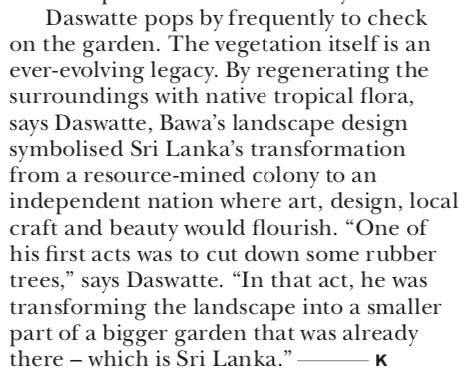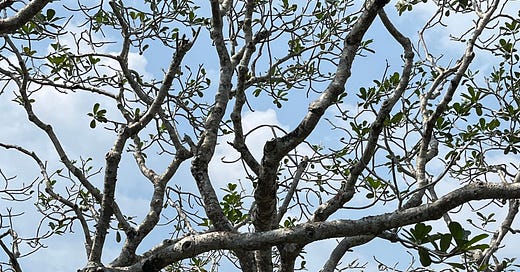The drive to Lunuganga is unassuming: villages, a narrow dirt road, then greenery on all sides. It’s late afternoon when we arrive, and butter yellow sunlight filters through the trees, dappling the ground with patterns that move in synchrony with the wind-stirred branches.
We climb a grassy knoll and enter the main house, a 1930s plantation bungalow overlooking serene Dedduwa Lake. A dedicated team of horticulturalists and gardeners carry out the delicate task of maintaining the grounds, which deliberately teeter on the boundary between kempt and wild.
Lunuganga, a 25 acre country estate in Sri Lanka, was the lifelong preoccupation of Sri Lankan architect Geoffrey Bawa (1919–2003), the pioneer of tropical modernism and one of the 20th century’s greatest architects.
In 1948, Bawa purchased an old rubber estate about halfway between Sri Lanka’s capital, Colombo, and the old southern port of Galle. He’d spent the previous two years on a grand tour of Europe, Asia and America, and his time in Italy stirred a desire to construct an Italian garden of his own. He was a 29-year-old lawyer with no training in architecture or landscape design. But he had some money from his dad and an uncompromising vision of beauty. He deserted the legal profession, retrained as an architect, and spent the next three decades designing Lunuganga, carving a tropical Eden out of agricultural monotony.
Lunuganga is large, and you can wander around for a long time before you realise its immanent sense of wellbeing and harmony is the work of Bawa’s relentless and invisible hand: the breakfast table with a straight-line prospect of the forest-obscured stupa on a distant hill, the checkerboard flagstones that alternate with grass squares, the charming Tuscan-ochre house on the opposite shore of the lake that you later discover is a government irrigation office, and had an unsightly corrugated iron roof until Bawa paid for its renovation and repainting in order to improve the view from the terrace – his favourite spot to sit with a gin and tonic and watch the sunset.
There is a decades-old frangipani tree – in fact it is two trees – shaped by Bawa, using bonsai methods, into a distinctive curved symmetry. Decades ago the young branches were weighed down with stones tied to their limbs so that they grew low to the ground and now, older, graze it, running parallel to the grass before reaching upwards into the sky like grasping claws.
Scattered around the property are mini Roman pavilions, Grecian nude statues, bulbous Ming dynasty grain jars, sculptures and statues and salvaged lampposts (taken from Colombo and refashioned into columns for an outdoor gazebo). Bawa loved black-and-white, so there are prettily panelled black-and-white doors, black-and-white checkered floor tiles, and – when he was still alive, but sadly no more – black-and-white cows roaming the gentle slopes.
The terraced gardens leading down to the lake are riotous with trees – ebony, balsa, Java plum, Spanish cherry and mangrove. Waterhens mince daintily through the grass; parakeets, barbets and bulbuls chirp and flutter among the leaves; Brahminy kites circle in the sky and at dusk, a fleet of bats makes its way over our heads, their silhouettes unmistakable in the waning light. The cumulative effect is one akin to magic.1

I’ve only touched the surface of Lunuganga’s beauty and power – I haven’t mentioned the levels of landscape, the antique furniture, the artwork, the picture-frame perfect doorways and windows, the Sri Lankan parliament in miniature, the endless details and the genius calculations of appearance and effect, the staircases, the bells – but I think it might be the most beautiful place I have ever been. At least that is how I felt when I was there, two months ago, and how I feel now, recalling it.
Ideally you should visit yourself – there are garden tours, open to the public, or rooms if you have some cash to spare – or check out the little reel I made from videos I took there in February, which I think evokes the place better than anything I’ve written. I agree with Bawa here:
I have a very strong conviction that it is impossible to explain architecture in words - I have always enjoyed seeing buildings but seldom enjoyed reading explanations about them - as I feel, with others, that architecture cannot be totally explained but must be experienced. —Geoffrey Bawa, “Statement by the Architect”
Happy International Workers’ Day!
Armed with the Merlin Bird ID app, I became joy-crazed with information. The overlapping song of many birds, already a delightful orchestra, became a live-update poem when I activated the app’s microphone and the names of birds started popping up on my phone screen, pop pop pop: white-breasted waterhens, rose-ringed parakeets, coppersmith barbets, red-vented bulbuls, white-browed bulbuls, brahminy kites, pale-billed flowerpeckers, asian emerald doves, spotted doves, black-hooded orioles, stork-billed kingfishers, purple-rumped sunbirds, etc., etc., glorious etc.!




